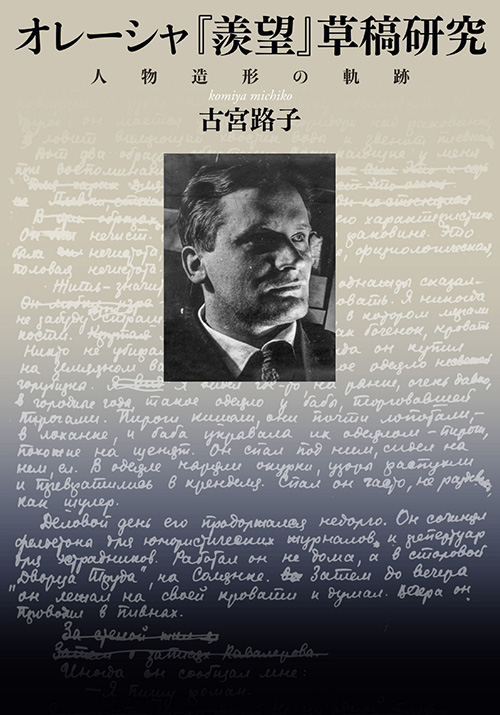
Title
Olesha Senbo Soko Kenkyu (Research on the Drafts of Olesha’s Envy - The Trajectory of Character Modeling)
Size
240pages
Language
Japanese, Russian
Released
December, 2021
ISBN
978-4-86520-058-4
Published by
Seibunsha
Book Info
See Book Availability at Library
Japanese Page
I think a great many people have at least once harbored the dream of wanting to become a writer and writing a novel. Using clues from over 1,000 pages of Olesha’s drafts that show how he handled the challenge of writing his first full-length novel, Envy (1927), this book follows the trajectory of Yury Olesha (1889-1960) from the time he was a young and unknown lover of literature in Odessa until he appeared like a comet on the literary scene of the Soviet Union after the Russian Revolution.
There are indeed a wide range of creative styles, depending on the author. In Olesha’s case, he did not begin by drawing up a plan for the whole novel. He started out writing the novel by creating several major characters and then writing fragmentary scenes about the characters as they occurred to him. The draft for Envy consists of an accumulation of innumerable episodes created in this way. As Olesha was writing without a plan, both the story and the personalities of the characters changed considerably during the writing process. In the earliest drafts, the main character of Envy was the eccentric inventor Ivan Babichev, whose bizarre behavior was recounted by the nondescript young man Kavalerov as narrator. As the writing progresses, however, one after another Olesha gave Kavalerov intensely negative characteristics. As a result, Kavalerov surpassed Ivan Babichev in terms of presence, and finally became the main character of the novel. Characters such as Ivan’s younger brother Andrey Babichev, a high official in the Soviet government; the beautiful heroine Valya; the model Soviet youth Volodya, and the repulsive Anechka, who fell on hard times and became a cook after the revolution, were gradually added to the novel, giving birth to increasingly colorful episodes. It is just as if the potential for an infinity of stories was opening up inside Olesha’s mind. But almost none of these episodes were incorporated into the published Envy.
Research into the drafts of Envy began in Russia in the 1960s, but thus far the outcomes have been only partial. The reason for this is the condition of the drafts. These consist of disorganized sheets of paper for which even identifying the chronological order in which they were written is difficult, since almost none of them are dated. The aim of this book was to identify how the character profiles were generated by classifying the drafts according to each of the major characters using similarity and proximity, such as of content and writing style, as clues for reordering the sheets of the drafts. Finally, how the story of Envy transformed throughout the whole period of the writing process was successfully clarified using the trajectory of character modelling as clues.
Due to the novel Envy, Olesha made a spectacular debut as a writer, but his active life as a writer spanned only ten years. When the Stalin regime came to power, the norm of socialist realism was imposed on writers, and as they lost the freedom to create, Olesha was deprived of the opportunity to publish, since he was considered to be “an author of doubtful thought.” In despair and leading a bleak life, even the infinite creativity that Olesha displayed in Envy were eventually exhausted. The disharmony Olesha felt with Soviet society was already apparent in Envy. The hero Kavalerov, to whom Olesha gave negative personality traits, was the “anti-social” antihero who was unable to adapt to society after the revolution, and the main theme of the novel is precisely the friction generated between Kavalerov and the “society” which compels him to “reform” his thought. The intellectual Olesha’s anguish that arises from the inability to adapt to Soviet society, where the worker is the hero, oozes out from each and every page of the drafts.
(Written by: KOMIYA Michiko / June 20, 2022)
Related Info
The 2nd UTokyo Jiritsu Award for Early Career Academics (The University of Tokyo 2021)
https://www.u-tokyo.ac.jp/ja/research/systems-data/n03_kankojosei.html
Related articles:
The Relationship between the Hero and the Narrator in Yury Olesha’s Envy
Michiko Komiya (Russian and East European Studies Volume 2015 Issue 44, p.56-59 2015)
https://doi.org/10.5823/jarees.2015.56



